Redbubble: At a Glance
- Redbubble is an international print-on-demand online marketplace located in Melbourne, Australia, San Francisco, U.S. and Berlin, Germany.
- Designers and artists can easily upload and sell their artwork without any costs or overhead.
- Redbubble stands out for giving sellers the ability to choose their own profit margin.
- It’s widely considered one of the best print-on-demand online marketplaces for artists to sell original work without a financial investment.
Pros
A leading advantage of Redbubble is its pricing flexibility that gives sellers the ability to set their own profit margins. This is a huge selling point—and a rare feature among its direct competitors. Additionally, it is also very user-friendly and has a lot of options in terms of wall art, enabling buyers to choose whether they simply want a print, a print on canvas or a framed print—complete with a wide variety of frame and matting options. For artists, this is helpful because it can make your designs more appealing to potential customers, opening the opportunity for more sales.
Cons
One of the most common frustrations among Redbubble users is that it’s common for sellers to get suspended without warning or information as to why. While it’s possible to appeal this decision, this can be troublesome for those who have invested a good deal of time into building out their products on Redbubble, only for their designs to be removed without notice. And it’s not necessarily a quick or easy process, as Redbubble is lacking when it comes to customer support. Instead, it depends heavily on its help center and a chatbot to direct users to specific pages in the help center.
Featured Partner
1
GotPrint
$9.80 for 100 business cards
Yes, for all Industries
Fast & On Time
How Redbubble Works
Redbubble is a print-on-demand marketplace, meaning that sellers upload their original designs to the platform, which are then listed for sale on various products (e.g., clothing, mugs, stickers, etc.). Unlike other print-on-demand services, products are sold on the Redbubble marketplace, which helps reduce the need for marketing and brand promotion compared to selling directly. So, when a customer places an order, Redbubble automatically prints, packs and ships the product directly to the customer.
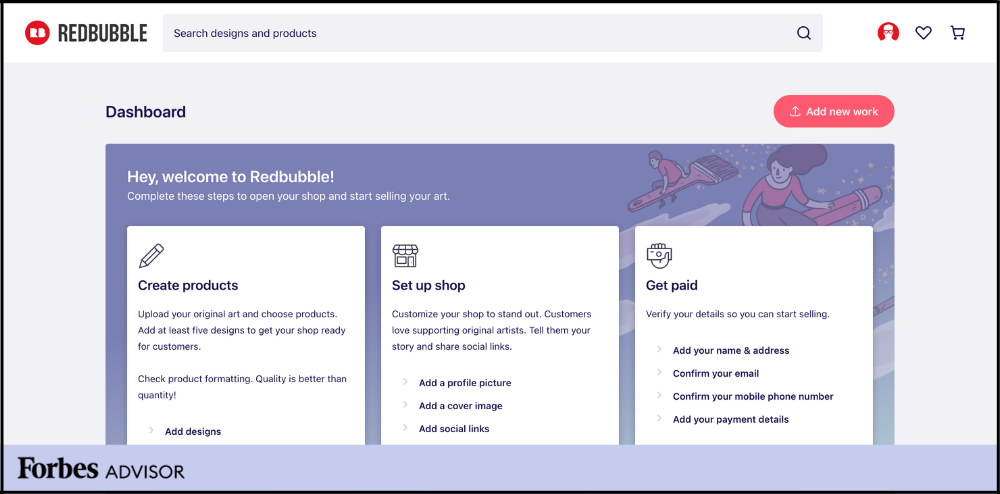
Redbubble Core Features
As a print-on-demand online marketplace, Redbubble’s key features include its existing customer base, its sizable product catalog and automatic product shipping. Together, these core features are what powers Redbubble as a service provider and what empowers individual artists to sell their products—without incurring the expense of starting their own business, having to market extensively to sell products or having to manage inventory or product shipments.
Existing Customer Base
Redbubble is not simply a print-on-demand service that connects to a business’s website, but a print-on-demand marketplace where customers go to purchase products. In fact, it’s an online marketplace that averages around 40 million monthly site visitors—all shopping for unique printed products. In other words, it’s similar to online marketplaces such as Etsy, eBay or Amazon in that consumers visit these sites to browse and purchase products, which in turn, helps reduce (if not eliminate) the need to market products in order to land sales. This is good news for creatives who are looking for an opportunity to sell their original designs online without investing a great deal of time or money into marketing and advertising.
Product Catalog
Compared to other print-on-demand platforms, Redbubble does not have the largest product catalog with just 70-plus items. However, despite this fact, it does offer one of the largest array of wall art-related products and options. For example, wall art is available in various sizes, printed on a variety of different materials, such as photographic paper, poster board, canvas, metal or even as a tapestry. Plus, it has a vast frame selection—giving buyers a good deal of choice and enabling them to find the right option that fits what they are looking for.
Shipping
Along with any print-on-demand service, Redbubble automatically prints, packs and ships orders. However, unlike some of its competitors that notoriously take a very long time for products to arrive, Redbubble is one of the faster providers, which normally delivers products in about seven days. Granted, in a world where consumers have become accustomed to very fast shipping thanks to companies such as Amazon, seven days is still a fairly long time. But again, it is shorter than many others, so it is a better option for sellers, as faster shipping times tend to play a role in customer satisfaction.
What Sets Redbubble Apart
Redbubble stands out for a couple of reasons. First, it allows sellers to customize their profit margin (or royalty), which is unique in the print-on-demand online marketplace industry. While standard print-on-demand service providers enable sellers to set any price they wish, the print-on-demand marketplaces tend to have a fixed profit margin, meaning that sellers have no control over their final sale prices—or profit per sale. Second, Redbubble has one of the largest sections of wall art options, making it a really good choice for designers and photographers.
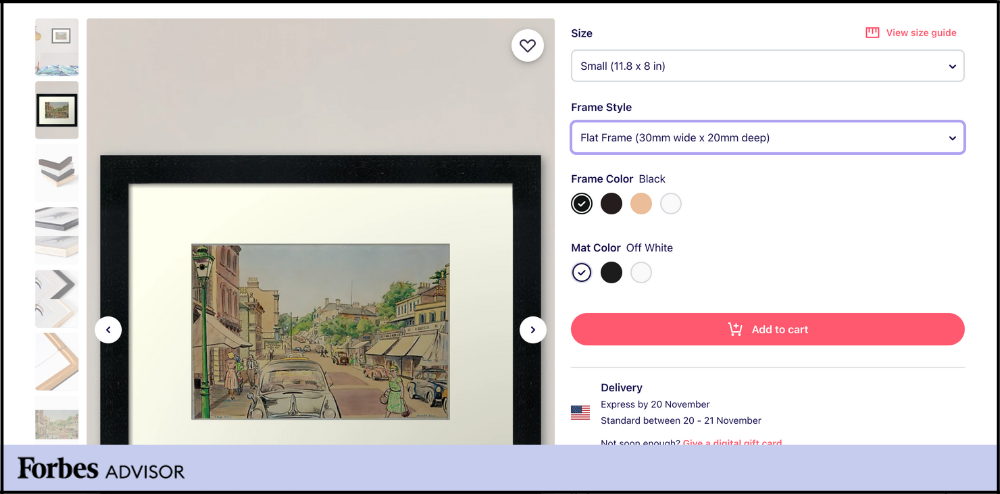
Redbubble Pricing
Redbubble is free to use, so there are no upfront costs or fees to use the platform to sell designs. The way earnings work is that sellers get a commission from sales, which is a set profit margin. And unlike some of its competitors, Redbubble does not have a fixed profit margin. Instead, its standard 20% profit margin can be changed by sellers, giving them more control over their product pricing. This is particularly helpful for those who are looking to sell high-end art or photography as well as those looking to build a brand.

Redbubble Setup
We found the process of getting started with Redbubble very straightforward. To start, go to Redbubble and click the “Sell your art” option in the upper right-hand corner of the screen. On the following page, click “Start selling.” Next, you will be prompted to create an account using your email address and you will be required to select which type of account you wish to create (artist/seller, customer/buyer). From there, you will be redirected to your new user dashboard, which clearly directs you to your next steps: create a product, set up a shop and get paid. All steps are very simple, and Redbubble makes it very easy to upload designs, add shop details (i.e., upload a profile picture and cover image) and add your payment details.
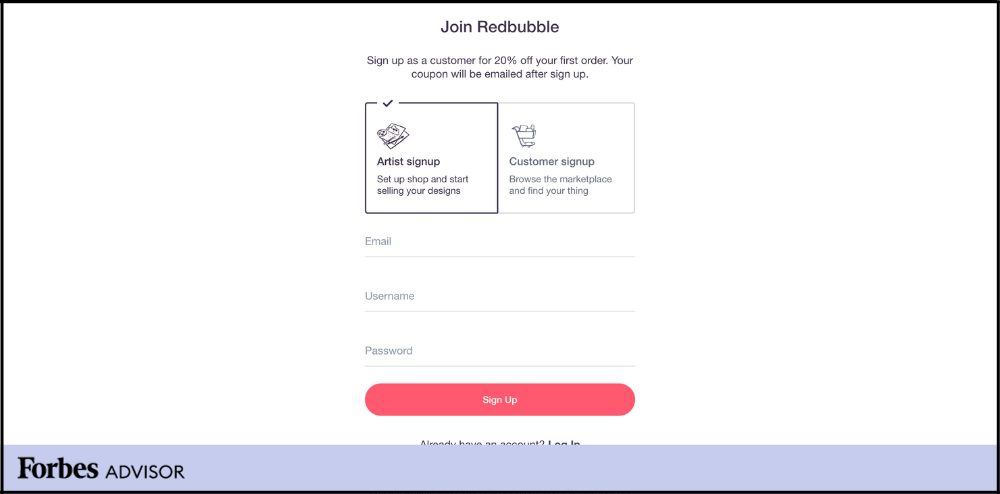
Redbubble Ease of Use
What’s nice about Redbubble is that it’s very intuitive and therefore easy to use. I find that it does a good job of walking users through all required steps, which helps to prevent errors or issues. Also, unlike other print-on-demand services, it automatically feeds designs into its online marketplace. Moreover, it does not connect to third-party sites, such as your own business website or other marketplaces, which makes it a breeze to set up, as there is nothing to connect, sync or configure—simply create new designs to be sold on Redbubble.
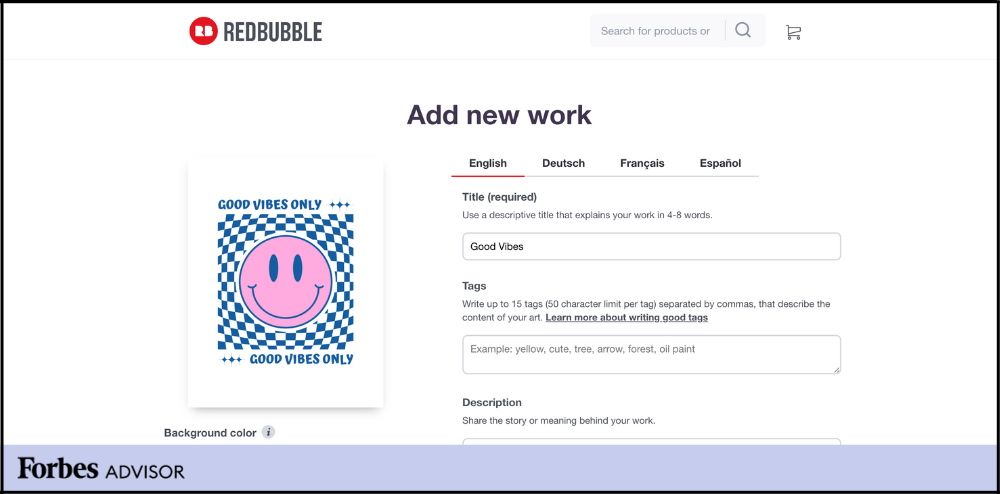
Security
Redbubble offers very little by way of user-controlled security settings. While it has all necessary built-in security features, helping to ensure security of the marketplace and the information of its buyers and sellers, it does not offer much in terms of what a user can do to enhance their security. For example, it does not offer two-factor authentication, nor does it allow multiple users and therefore does not have user roles and permissions. For the most part, its lack of user roles is not an issue, as the average user is an individual posting designs, but there are some instances where this option would be helpful to certain users.
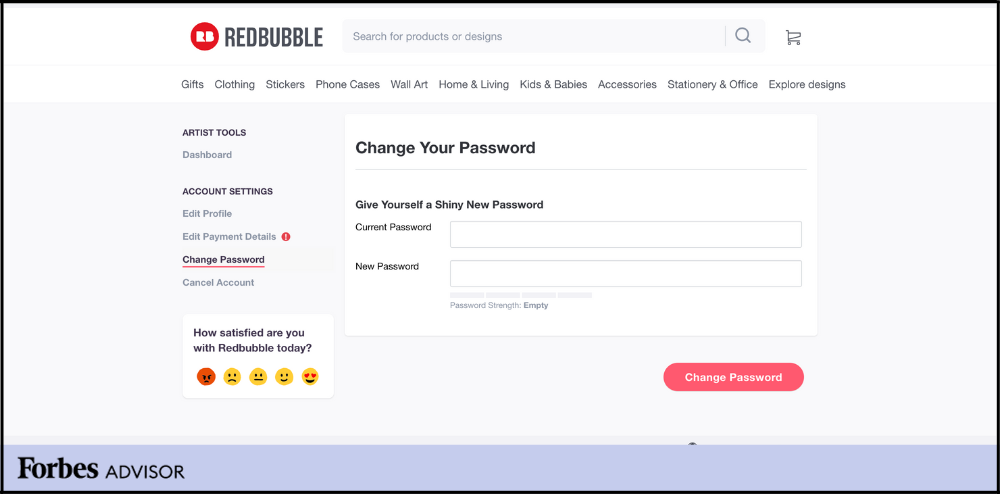
Redbubble Customer Service and Support
One of the things we find most disappointing about Redbubble is its customer support—or lack thereof. While most print-on-demand platforms provide live support in various channels, Redbubble offers very limited support. It oddly doesn’t offer direct access to chat support from within the seller dashboard like most. Instead, it leans on its help center, which is comprehensive but not an ideal way to get assistance in instances where users have unique questions or need immediate help. It does have a chatbot, but keep in mind this is not live chat.
Redbubble Alternatives and How They Compare
Redbubble vs. Zazzle
Redbubble and Zazzle are two direct competitors that lead the print-on-demand online marketplaces. However, while the two both offer creatives an easy and free way to sell print-on-demand products with their custom designs online, one major difference is that Zazzle has a fixed commission that gives sellers little control over profit margins. Meanwhile, Redbubble gives sellers the ability to set their own profit margin. On the other hand, Zazzle is superior to Redbubble when it comes to support and the fact that it does not have a limit on the number of daily design uploads like Redbubble.
Redbubble vs. Gelato
When comparing Redbubble and Gelato, there’s a major difference in that while they are both print-on-demand services, Redbubble is also a print-on-demand marketplace where users can sell their designs. With Gelato, users must connect to their website or third-party platform of choice, so there is no built-in customer base like there is with Redbubble. Another difference is that Gelato offers sellers more choice in terms of which products they can sell, and its customer support is available 24/7 by live chat—unlike Redbubble, which has a chatbot that refers users to the help center.
Redbubble vs. Printful
Redbubble and Printful both give creative types a way of easily uploading original graphics and designs to be sold on products. However, Printful is not a print-on-demand marketplace like Redbubble is, so it’s better for those who are looking to build a brand and sell their products across a variety of sales channels. As with Redbubble, which enables users to set their own profit margins as a fixed percentage (e.g., 20%), Printful enables users to have complete control over their profit margins but by setting their own sales prices and factoring in profit margins per product.
Featured Partner
1
GotPrint
$9.80 for 100 business cards
Yes, for all Industries
Fast & On Time
Who Is Redbubble Best For?
Redbubble is best for artists and creatives who are looking for a way to make a passive income online by sharing their work. This is because it offers the most wall art options for buyers and gives sellers control over their commission. This way, an artist who is selling higher-end designs can price their designs accordingly and consumers can purchase them in a format that suits them best (i.e., canvas, framed, print, etc.). It’s also a good choice for those who are looking for a simple way of selling artwork online without any costs or overhead.
Conclusion
Redbubble is a solid print-on-demand marketplace. However, that doesn’t mean it’s ideal for every seller. For example, it’s not geared towards creatives who are looking to sell physical goods, such as handmade or vintage items, since it’s a print-on-demand marketplace only. It’s also not well-suited for those who are looking to build a brand, as it does not connect to your website or other online marketplaces the way many print-on-demand service providers do, such as Printify, Printful and Gelato.
Frequently Asked Questions (FAQs)
How much can I make on Redbubble?
Every seller earns a different amount of money on Redbubble based on a variety of factors, such as their number of sales and types of products sold, chosen profit margin and number of designs uploaded. Sellers get paid based on sales and what they set their profit margin to, which defaults to 20% but can be changed to the seller’s liking.
Which is better: Redbubble or CafePress?
Redbubble and CafePress are two print-on-demand marketplaces, leaving many prospective sellers wondering which is right for them. In short, Redbubble has more product types available than CafePress, and it gives sellers the freedom to choose their own profit margin, which can make a major difference in terms of profit potential compared to CafePress, which is set at a 5% commission.
Is Redbubble better than Etsy?
Redbubble is not necessarily better than Etsy, but it is better than Etsy for artists who are looking for an easy way of selling their artwork online. This is because Etsy requires sellers to use a third-party print-on-demand service whereas Redbubble is a print-on-demand service and an online marketplace in one. On the other hand, Etsy is better for those who are looking to sell physical objects, such as handmade items and vintage goods. For additional insight, learn more about how to start an Etsy shop.
This post was originally published on this site be sure to check out more of their content






